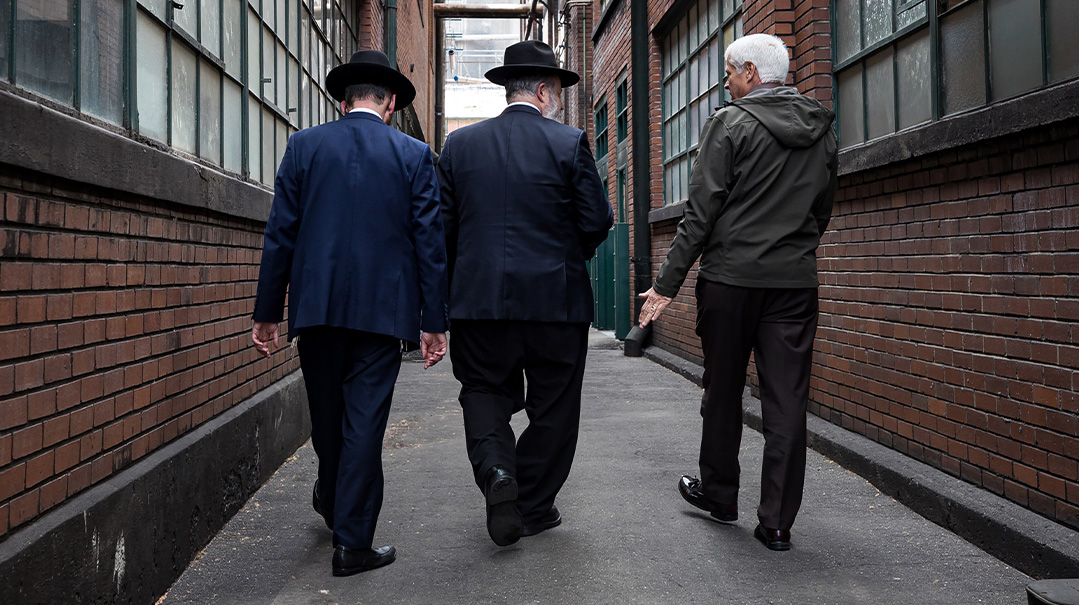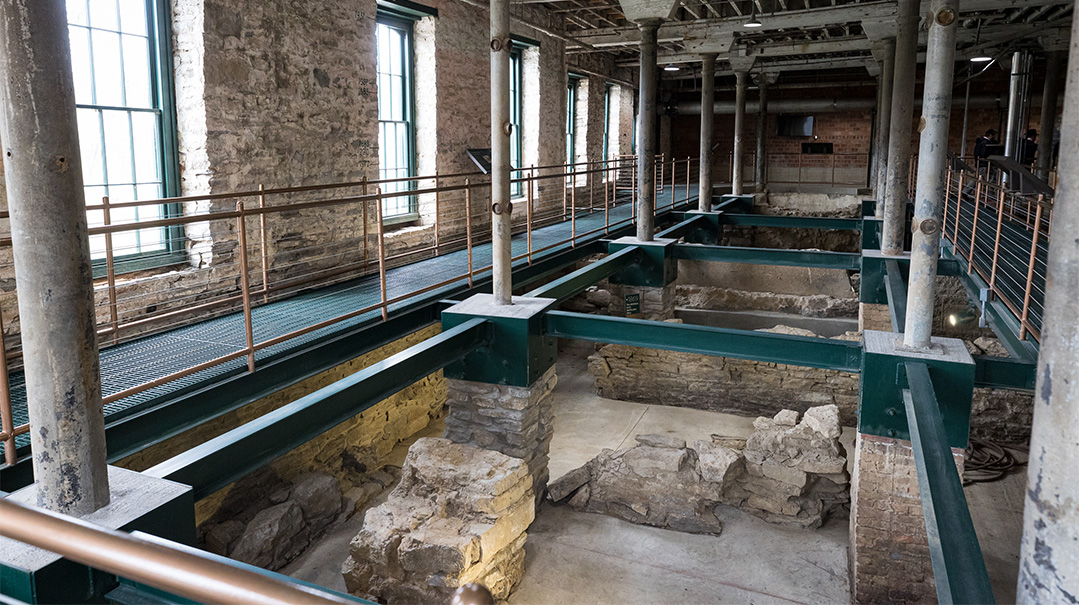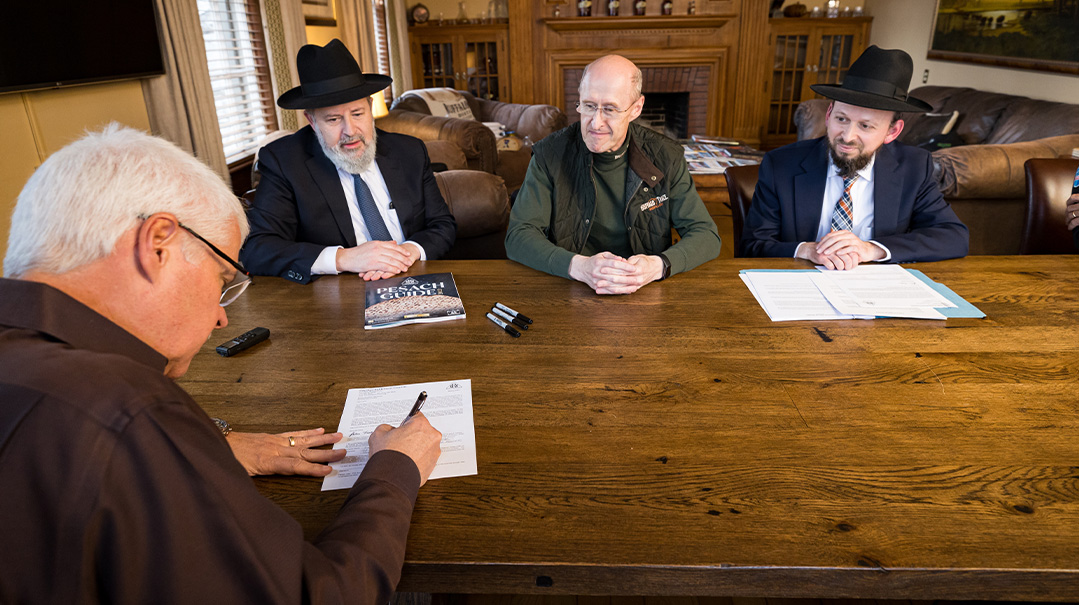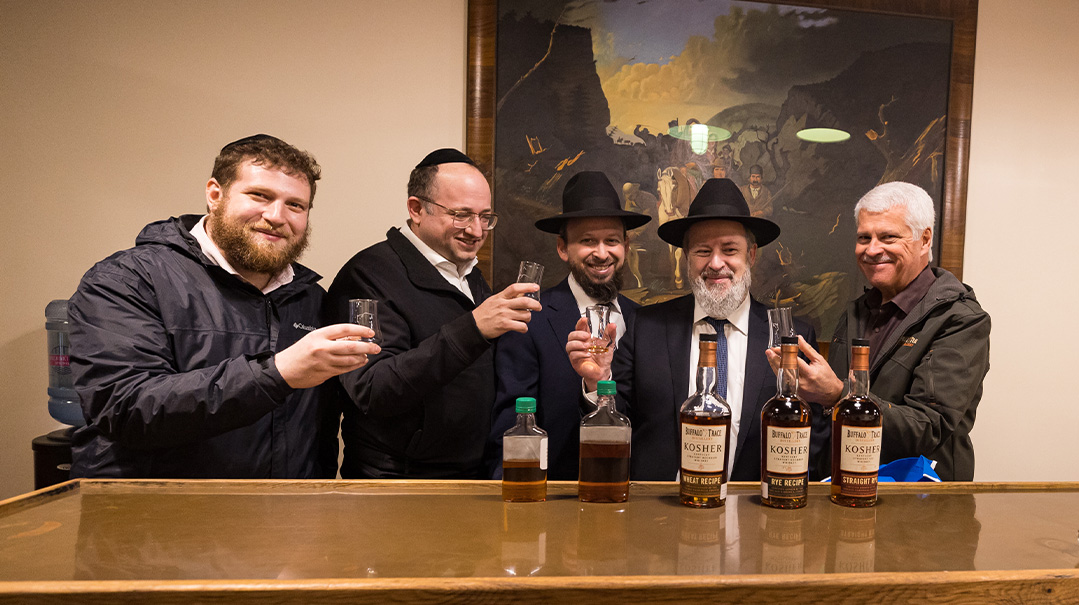Liquid Sale

With their chometz safely sold, the folks at Buffalo Trace distillery in Frankfort, Kentucky, gear up to uncork the results

Photos: EquiSport Photos
“IF we’re selling our chometz, it has to be done right, no shortcuts,” says Mark Brown, president and CEO of Sazerac Company, the second-largest spirits company in the US and parent company of Buffalo Trace bourbon. Mark might not strike you as the man responsible for thousands of bottles of some of the best bourbons out there, manufactured in the same Kentucky factory and rickhouses where it’s been done for the last hundred years. But don’t let Mark’s charming, laid-back accountant-like demeanor and British accent fool you — he knows bourbon better than anyone in the state of Kentucky, and is determined to make sure observant Jews can enjoy it as well.
Yet Mark was never anyone’s Shabbos goy and didn’t grow up among Jews. His Welsh roots carried him on a journey from being a door-to-door salesman in London’s East End to moving up the corporate ladder and landing the top spot at Sazerac, where he has grown the company as its CEO for the last 25 years. He may have been born in London’s East End at a time when scotch was the only drink served, but he’s grown his business empire into a conglomerate of 400-plus beverages, spanning several continents. And the crown jewel of Sazerac’s empire and the reason their corporate offices are housed in nearby Louisville is the place we are standing today: Buffalo Trace distillery in Frankfort, Kentucky. These well-worn grounds also make Blanton’s — the bourbon known for its metal horse top of every bottle, Eagle Rare, E.H. Taylor, and so many others.
So why are Sazerac CEO Mark Brown and master blender Drew Mayville meeting with Rabbi Sholem Fishbane and Rabbi Akiva Niehaus from Chicago’s cRc today?

Thousands of bottles of kosher bourbon are the latest product to emerge from these century-old Kentucky rickhouses, where guests can still walk through the old fermenting rooms (right)
Bourbon Backwater
The drive to the Buffalo Trace distillery in Frankfort is a throwback to the American heartland of a bygone era. We pass through quaint small towns, each with its own personality. We pass the general store that sells both guns and milk, and the soda shop where Pop Tate is fixing root beer floats while mellow jazz plays from the jukebox. There is no police station in these parts — the locals know where the sheriff lives by the big Dallas star that prominently adorns his house, signaling to passersby like us to slow down as we peek in.
Getting closer to the distillery, the scenery changes ever so slightly. Corn fields and farms stretch for miles on end, and it doesn’t surprise us when, after the meeting with the rabbis, Drew informs them that their plan to get an Uber back to the airport is nothing more than a big city dream (he arranged for an employee to drive them). As we pull up to Buffalo Trace we see the slogan come to life: “Honor Tradition, Embrace Change.” As bourbon takes years to mature in bottles, you can almost breathe the laid-back environment through the air. The aromas of fermenting yeast are reminiscent of challah-baking, and those vats of bubbling mash remind you of cholent bubbling on a late Friday night that was mistakenly left on high. We are transported back to a 19th century European village as we observe coal-burning machines of more than a century ago and a labyrinth of underground cisterns in the fermenting room — built back in 1883 — that are still used for special runs.
As we drive up to this part-factory, part-tourist destination complex, we’re greeted by our golf-cart guide who navigates a few steep hills until we arrive at Stony Point Mansion, where some of the offices are housed. This mansion was built by Colonel Blanton, whose leadership of the company allowed it to survive and thrive through the Great Depression, the Great Flood of 1937, and World War II. He passed away just upstairs in 1959, starting haunted-house legends that have kept ghost-hunters busy for years. Right outside this majestic mansion you can still see the area where old buffalo “trace” — or roadways — were used by buffalo roaming the vast swaths of land in centuries past.
A few minutes later, an Uber SUV pulls up outside the mansion and out comes Rabbi Sholem Fishbane, director of kashrus for the Chicago Rabbinical Council (cRc) and executive director of the Associated Kashrus Organizations (AKO), together with Rabbi Akiva Niehaus, cRc’s director of kashrus operations and its rabbinic coordinator of the liquor industry. These fellows all seem like old friends, and after some hugs and handshakes, they get straight down to business, extracting from their wheeled suitcase a smorgasbord feast of Chicago’s best kosher delights — pastrami, cold cuts, salami sticks, and chopped liver from the Romanian Sausage Factory of Skokie. How apropos — old-school Jewish deli (Romanian’s storefront hasn’t changed in 50 years) meeting 19th-century bourbon making, a shidduch that any kiddush club would die for.
Master blender Drew Mayville answers our questions between bites of his corned beef sandwich. A native Canadian, he spent 23 years with Seagram’s before moving to Kentucky in 2004. Drew’s passion for bourbon led him to embrace the changes the industry has seen, and his own invention, “Mister Sam Tribute Whiskey,” pays homage to his Seagram and Canadian roots, a blending of Canadian and American whiskeys and named in honor of Samuel Bronfman, the Jewish philanthropist and businessman who left an indelible impact on Drew’s life and career.
“What’s your favorite liquor?” I ask Drew. “The one we haven’t made yet,” he says. He’s always tinkering and experimenting to get that perfect product.
At exactly 1 p.m., CEO Mark Brown arrives. If I expected a buttoned up CEO who would get right down to the business at hand, Mark wasn’t it. He’s the kind of chilled guy-next-door that you just want to have a beer with (or share a bottle of bourbon with). His frankness comes through within the first few minutes. “Do you know the Orthodox plumber from Brooklyn, or a fellow named Benzion Lamb who I think is in the automotive business in New Jersey? I promised Benzy he would get the first kosher bottle we made, and he got that first bottle.”
“How do you know them?” I ask the CEO of this multibillion-dollar company, not someone I expected to play Jewish geography with. “They email me,” he says.
His email address is listed on the Buffalo Trace website. “In the few minutes I’ve been sitting with you, I’ve probably received several customer emails. Some are hysterically happy fans gushing about a barrel pick they just consumed. Some want to know where to get it. Some are angry about something or another. But some of the best ideas actually came from these customer emails.”

Drew (left) is signing to give official permission on behalf of the company for Rabbi Fishbane to serve on behalf of the owners to sell their chometz, while Mark (who will purchase the chometz) and Rabbi Neihaus look on. Mark even did a DNA test to make sure he wasn’t Jewish
Over a Barrel
The Pesach part of their story, the part that brought us here today, started about a dozen years ago. One of Buffalo Trace’s labels also makes vodka, and they applied to have it certified kosher, as it was being imported to Israel. At the end of their meeting and after agreeing to make the vodka kosher under the stipulated conditions, Rabbi Fishbane asked one last parting question: “By any chance, is there any Jewish ownership here?” Mark looked at him squarely and responded with a very tempered “Yeah…” unsure whether Jewish ownership was a good thing or a bad thing.
For the next six months, instead of giving certification on the vodka, the cRc opened a full-scale investigation into the Jewish ownership of Sazerac. New Orleans philanthropist and billionaire Bill Goldring is chairman of the Sazerac Company, and head of the family that owns Sazerac. His grandfather, Newman Goldring, founded Sazerac back in 1898.
Rabbi Fishbane then had what he describes as one of the hardest conversations when he picked up the phone to call his new friend Drew, whose product he was asked to certify. “Not only can’t we certify your vodka, but we also have an obligation to tell everyone that all of the thousands of bottles you produce each month are problematic.”
In 2010, under the AKO banner, Rabbi Fishbane began issuing lists of problematic bourbons. Buffalo Trace and the other labels they produce were included on a list of products from Jewish whiskey makers or distributors that have chometz she’avar alav haPesach issues and not only can’t be purchased, but any of these products in schnapps cabinets and store shelves must be discarded.
This prompted Drew and Mark to look into all the angles and bring Sazerac’s Jewish owners into the conversation. The owners were aware of alcohol kashrus issues related to mevushal, but unsold chometz was not on their radar.
“The irony is that because we are Jewish-owned it makes it more complicated — one would think the opposite, if you’re Jewish-owned you would expect to have the inside track on how to be kosher,” Mark says.
For Buffalo Trace to resolve its chometz issue, “It all comes down to authenticity,” Mark emphasizes. “I don’t believe in doing things halfway, so when the kosher subject came up, it would have been very easy to find a rabbi to do some drive-by kosher-ing for us. But that wasn’t going to work.”
There were lots of options to move forward — such as selling the whole factory for Pesach as another distillery nearby has been doing for years. But Mark and Drew wanted something different and unique, a kosher product they would create from the beginning. It would’ve been simpler to take the popular Weller recipe or another bourbon already in existence and steal away a few of those barrels to mark as kosher. Instead, they decided to create a whole new bourbon called the “Kosher Experiment” and have specific casks be earmarked as kosher, sold to a non-Jew before its first Pesach, and aged until they were ready, which can take up to seven years. Making an independent kosher label instead of putting a kosher label over existing bottles gave the Buffalo Trace leadership control over the supply chain of this new small batch bourbon project.

Sam and I joined Rabbi Fishbane, Rabbi Neihaus, and Drew for a l’chayim on this year’s post-Pesach batch at cask strength. You can’t miss the kosher label on these bottles
Cask of Characters
This wasn’t the first wild project these innovative partners decided to implement. For instance, after a 2006 tornado ripped through central Kentucky and blew off the top of their 1880 warehouse, rather than dump all those months-long sun-exposed barrels of bourbon, they tagged them, held them to maturity, tasted them, and thought the whiskey was surprisingly great. The fans agreed that the sun, rain, and elements of that summer did something special, which made these Colonel E.H. Taylor, Jr. Warehouse C Tornado Surviving Bourbon bottles the most sought-after bottles released that year.
Mark’s email address is open for all, and that accessibility has also helped grow their business with fresh ideas. They once had a consumer named John from Charleston, West Virginia, who emailed, “I love your whiskey, but you don’t make anything barrel strength or full proof.” Mark wrote back in a politely British way, “That is the most ludicrous thing I’ve ever heard, no one in their right mind would buy barrel proof whiskey, never going to happen.” John wrote back equally politely, “You would be surprised.” And Mark and Drew, never ones to back down from a challenge, tested the market in a way that would bring out the truth. They performed a Kentucky-style focus group by rounding up a group of 20 local retirees in the 75 to 95 year-old range who’d been drinking bourbon for at least half a century. They all joined together one evening in the master distiller’s room at Buffalo Trace with these barrel strength bourbon samples Drew cooked up in his secret laboratory.
“The senior citizens loved it,” Mike says, “and then they told us, ‘We all think this is the whiskey you should release, barrel strength.’ That whiskey became the award-winning George T. Stagg, but when people look at a bottle of Stagg, they don’t realize the idea came via a fan email from a man out in Charleston and created by a group of intoxicated retirees having a great deal of fun.”
Sam Shaffer, my resident bourbon expert who joined the trip, took this information as an opening to petition CEO Mark that Buffalo Trace make a run of the kosher bourbon at barrel proof. Typically, the bourbon is cut with water prior to bottling in order to lower the alcohol percentage. But Sam and many bourbon aficionados like their bourbon strong, bold, undiluted, and at cask strength, rather than cut. Sam made a strong pitch to Mark and Drew that he and many of his Jewish bourbon brethren would love them to make a cask strength kosher run.
After our tour, we all tasted this coming post-Passover’s batch at cask strength, which is currently owned by Mark until after Pesach and which he was willing to share with his guests. The sheer joy on Sam’s face as he sipped this full-bodied bourbon was all the proof Drew needed that he should consider experimenting by bringing cask strength kosher to market.
Sold Out
Ten years ago, in order to come up with the kosher barrels, rather than siphoning off existing barrels, Drew created a whole new bourbon recipe for the kosher barrels. In his lab and with his equipment and happy taste-testers, Drew devised a blend before Pesach of 2012, when the first transaction took place. At that first chometz sale, Drew, on behalf of Sazerac, sold just 20 barrels he’d put away for Mark, who purchased them on his own behalf for a $20 down payment. Mark even went so far as to have the ancestry.com website run
his DNA to confirm that he was not Jewish, in order that the sale to a non-Jew be uncontroverted.
The plan was for Mark to hold onto these barrels in his possession, yet housed in Buffalo Trace until the barrels were ready to go to market, at which point he would sell them back to Sazerac after that Pesach, when they would be bottled and sold to distributors. Rabbi Niehaus personally autographed each of these first twenty barrels, so everyone from the people who transport the barrels, to those that move them around in the rickhouse during the next seven years they are housed there, would know these bottles are part of the Kosher Experiment, owned by a non-Jew named Mark Brown, and are not to be used for any purpose.
During our Pesach 2022 sale, 300 barrels (100 of each of the three bourbon styles — wheat, rye, and straight rye) were now dedicated toward kosher — that means a yield of up to 72,000 bottles of bourbon when it is bottled in seven to nine years from now. Rabbi Niehaus no longer autographs them, and they have more complex ways of tracking. This kosher project exploded beyond the wildest dreams of the Sazerac leadership and the cRc. Over the next seven years, the barrels that were sold today will be checked on periodically by cRc mashgichim who will visit the rickhouses, take in the intoxicating fumes of aging bourbon, and ensure that the barrels of kosher bourbon are exactly where they are supposed to be.
“Were you nervous that once you opened up the Kosher Experiment whiskey after seven years and tasted it you might have thought it wasn’t something you’d want to release?” Sam asks.
“Actually, yes,” Mark admits. “While it didn’t happen with Kosher, it happened just last year with George T. Stagg, which has become an iconic brand. Drew is responsible for tasting the barrels at maturity. Drew emerged from his smoke-filled tasting room and said, ‘We’re not going to release it because it hasn’t matured yet in a way that we would put the Stagg label on it.’” That had a considerable financial impact to the company’s bottom line, but quality control is of utmost importance. Those barrels had been sitting since 2006, so the pressure was intense to get them out, but “Barrels are a lot like children,” says Mark. “While you do your best, some turn out to be superstars and some don’t.” Patiently waiting to release the barrels gives them time to mature and the flavors to develop.
The timing of the kosher release is of crucial importance. Mark was nervous that while his new kosher bourbon is being sold in barrels according to strict halachah, once it gets bottled and sent to distributors, it will be out of his hands to control what happens the following Pesach.
Suppose, for example, that Buffalo Trace ships out the kosher bourbon to distributors in January, and it reaches stores by early March, and then suppose that Moshe Shimon comes to a store named “Liquor Supply” to buy that kosher bourbon with its prominent certification first in June. He assumes he’s buying this kosher labeled bourbon free of issues. In truth, Liquor Supply is owned by a Jew who does not sell his chometz for Pesach. So although this bottle was owned by non-Jew Mark Brown for seven years and had no chometz issues for those seven years while in the barrel, once it leaves Buffalo Trace, there is no way to know if a chometz issue was created for the next Pesach. To solve this, Mark came up with a plan to bottle the kosher bourbon right after Pesach and get it out to distributors as soon as possible. This way if it reaches stores by May, the kosher consumer has until the following Pesach to buy the bottles. The chances of a distributor or store still holding these bourbons and having them when Pesach comes around almost a year later are minimal, thereby minimizing the chances of any chometz issues before it gets to consumers.
The label not only has an emblazoned “kosher” all over the front, but explains the story of the Passover sale on the back, which confused a small number of consumers who did not read it carefully. “I got photographs on Passover of consumers enjoying a l’chayim with the bottle on Passover,” Mark says. People thought it was so kosher that they were actually buying it for Passover use. The label was rewritten for this year and states quite boldly, “NOT FOR PASSOVER USE” to prevent people drinking this golden liquid chometz with their matzah.
Little did Mark know how well his kosher experiment would succeed. With Drew’s delicious formula, the kosher whiskey released for the first time last year sold out quickly, and the chances of bottles lasting until this Pesach were close to zero. Liquor stores sold out of these bottles within weeks. Non-kosher consumers competed as well after the “bourbon hunters” deemed the bottles a collector’s edition and bought all the stock they could find.
“It has a cult following,” Mark Brown explains. With just 20 barrels released, it attracted a large and diverse following across the world. Perhaps it was the extra mile that Mark was willing to go, or the leap of faith that Drew was willing to take in developing an untested recipe for this kosher edition and needing to wait seven years to see if the experiment worked. Whatever it was, it worked beyond their wildest dreams.
As we sit here with these executives and rabbis to sell the chometz before Pesach 2022 (Rabbi Fishbane acted as the shaliach from the company/Mr. Goldring in arranging the sale), the shtar (contract) tells you a lot. No longer are they selling and dedicating 20 barrels for kosher, it is now 300 — but Mark is still paying Drew (on behalf of the company) the same $20 for it. What’s the actual value of those 300 barrels? “Around $3 million,” Mark replies. Well, that’s a pretty good deal.
After our annual sale is complete with multiple kinyanim, explanations, break for rugelach tasting, handshakes, and hugs, we are privileged to take a tour with Freddie, the tour guide, inventor, and all-around special person whose great attitude lifts up the spirits of those who get to spend a few hours with him. After visiting the factory and visiting the vats and learning about how bourbon is made, where the corn comes from, and why the river abutting the factory plays such an integral role, we are driven up some winding roads to the rickhouses, where bourbon barrels are stored as they have been for over 150 years. Up two flights of steps and down a creaky wooden floor we finally get to a section that is marked off as “Kosher.” These barrels sit here and wait and wait. When their turn comes, on that given year right after Pesach, they will grace the tables of Jews all over, confident that this bottle and its proudly-displayed kosher signage will serve as the perfect l’chayim for any occasion.
Yosef Zoimen is an attorney in private practice in Cincinnati, Ohio, and has been involved in the growth of the city’s Torah community.
(Originally featured in Mishpacha, Issue 908)
Oops! We could not locate your form.






